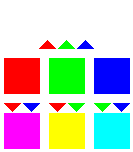Using colours from the Web-safe palette meant
that they displayed on all computers consistently.
If you used a colour that was outside the palette,
the browser would try its best to simulate the
colour using a process called 'dithering' where
pixels of Web-safe colours are juxtaposed to produce
the impression of intermediate colours. Sometimes
this works well, but often it makes the colours look
grainy or speckled, the effect being especially
objectionable where there are large areas of flat
colour or gradients.
Today's computers have more memory, faster
processors and don't suffer from the colour palette
restrictions of their predecessors. The need to use
the Web-safe palette for colour consistency has all
but disappeared, unless you are developing Web pages
specifically for that 5% that still have 8-bit
monitors. Sure, there are some 'old and trusted'
computers still out there somewhere, just as there
are some black and white televisions and
steam-driven radios, but the World moves on...
So, is it finally time to kill-off the Web-safe
palette? Can it safely be banished to the
fast-growing junk-pile of obsolete Web technology?
Many would say 'yes', but my vote is to keep it -
but for an entirely different reason.
Artist's paints were originally made from naturally
occurring pigments - colours like cadmium red,
cobalt blue, zinc white and burnt sienna. When you
mention one of these colours by name, a painter will
know exactly what colour you are referring to. Many
of these natural pigments have now been replaced by
cheaper synthesised equivalents, but their 'intentions'
remain the same.
In my art and graphic design training and career, I
have used palettes of one kind or another -
designer's gouache, Magic Markers, Pantone Colours.
These are all palettes, convenient sets of colours
where each colour is a definite entity with a name (or
PMS number).
There are many other sets of standard colours in
other trades, architectural paint colours, Munsell
colours for fabric dyes and pigments for colouring
plastics. The fact is, that having a small set of
readily identifiable colours to work with makes life
a lot easier than having to cope with a virtually
infinite number of colours – many of which are
redundant because they are indistinguishable from
their neighbours.
It is easier to juggle with fewer balls!
A palette of 216 colours is much more manageable
than the 17 million or so provided by a 24-bit video
card.
If you look at the 216 colours in the Web-safe
palette, many of them are too similar to be useful
and there are gaps where you wish there were
intermediate colours. The Visibone palette makes
this very obvious because it puts similar colours
together. Remember, this palette is based upon 20%
steps of red, green and blue, a progression arrived
at by simple numeric steps rather than being
determined by visual judgement. It is not ideal by
any means, but you have to start somewhere.
#EC0109 doesn't quite have the ring to it that 'cadmium
red' has and frankly, it is so imperceptibly
different from #FF0000 that it make no difference.
There will certainly be more variance between
different brands of monitor and computer gamma
settings than with these few percent.
So, I would say, keep the Web-safe palette as a
benchmark. Choose your basic colours from there, but
if you need colours that are not in that palette,
don't be afraid to mix your own. If you like a
colour, use it!
Extreme subtleties are a waste of time though. If
20% steps make little difference for some colours in
the Web safe palette, there is little point of
contemplating 5% steps.
Before you go any further, check out my monitor
gamma test and see how well your monitor copes with
basic colours. In general, monitors that are not
accurately calibrated - the vast majority - will
reproduce some, if not all colours inaccurately. The
worst offenders, I find, are cheap PC laptops, which
are totally incapable of any kind of subtlety at the
extreme light or dark ends, and even those colours
change with viewing angle. Many office PCs have no
colour calibration or any facility for adjustment,
in other cases, people just don't know how to, or
can't be bothered to set them up correctly. But two
wrongs don't make a right!
As a Web designer, it is your responsibility to make
sure that the colours you use are as accurate as
possible. Can you imagine what would happen if
record producers didn't care about the fidelity of
their sound recordings? Listeners with cheap
transistor radios would hear little if any
difference, but people with expensive hi-fi systems
would be quite justified in complaining about
sub-standard recording quality.

